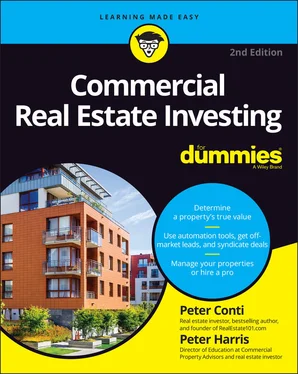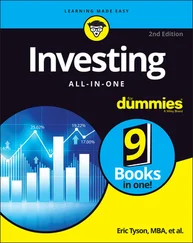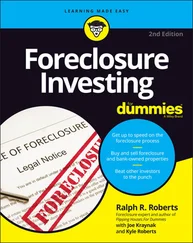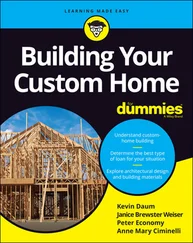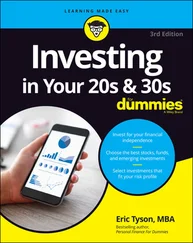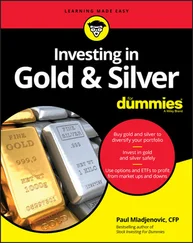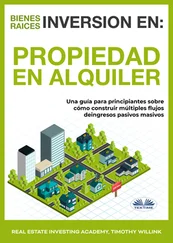Peter Harris - Commercial Real Estate Investing For Dummies
Здесь есть возможность читать онлайн «Peter Harris - Commercial Real Estate Investing For Dummies» — ознакомительный отрывок электронной книги совершенно бесплатно, а после прочтения отрывка купить полную версию. В некоторых случаях можно слушать аудио, скачать через торрент в формате fb2 и присутствует краткое содержание. Жанр: unrecognised, на английском языке. Описание произведения, (предисловие) а так же отзывы посетителей доступны на портале библиотеки ЛибКат.
- Название:Commercial Real Estate Investing For Dummies
- Автор:
- Жанр:
- Год:неизвестен
- ISBN:нет данных
- Рейтинг книги:4 / 5. Голосов: 1
-
Избранное:Добавить в избранное
- Отзывы:
-
Ваша оценка:
- 80
- 1
- 2
- 3
- 4
- 5
Commercial Real Estate Investing For Dummies: краткое содержание, описание и аннотация
Предлагаем к чтению аннотацию, описание, краткое содержание или предисловие (зависит от того, что написал сам автор книги «Commercial Real Estate Investing For Dummies»). Если вы не нашли необходимую информацию о книге — напишите в комментариях, мы постараемся отыскать её.
Commercial Real Estate Investing For Dummies
Commercial Real Estate Investing For Dummies — читать онлайн ознакомительный отрывок
Ниже представлен текст книги, разбитый по страницам. Система сохранения места последней прочитанной страницы, позволяет с удобством читать онлайн бесплатно книгу «Commercial Real Estate Investing For Dummies», без необходимости каждый раз заново искать на чём Вы остановились. Поставьте закладку, и сможете в любой момент перейти на страницу, на которой закончили чтение.
Интервал:
Закладка:
For some reason, Morgan had the wild idea that he could somehow make money investing in real estate. So, he drove around town talking to agents and looking at properties. One day he saw a sign on an empty lot that said, “Exxon Corporation Land for Sale.” Morgan didn’t know much about land, but after looking at the county records, he figured that the property might be worth about $200,000.
After calling and meeting with the agent, he was able to put a contract in place to buy the land for $160,000. But now Morgan had a big problem because the agent was calling about the $4,000 earnest money deposit that Morgan had promised to give to them. So, he went down to the bank and talked them into lending him the $4,000 based on the value of his car, which was the only real asset that he had.
Now Morgan was faced with the problem of having to close the deal in 120 days, or he would lose his deposit and perhaps his car, too. So, he went back to the county office and looked at all the other parcels of land around his piece that he had under contract. He saw that there was a larger lot behind his property that could have its access restricted depending on how he developed his property.
With the help of an architect, Morgan put together two sets of plans. One set showed a larger commercial shopping center that restricted access to the lot behind it. He also put together another set of plans with another smaller building designed as a gateway to the property behind it. Morgan’s next step took a straight face. He marched into a meeting with the owner of the property that was behind his property and dropped both sets of plans down. Morgan told the owner (in a nice way) that they had a choice: The owner could either accept a wholesale assignment of Morgan’s purchase contract for $320,000 so the owner could develop it with the gateway, or (if the owner didn’t want to buy it) Morgan was going to develop the property himself and restrict the other property owner’s access.
Morgan was scared stiff at this point because he knew that he didn’t have any way to close the deal himself. Fortunately, the owner agreed to the wholesale assignment of Morgan’s property for a total price of $320,000 — and after they went through the due diligence, the price dropped down to $290,000. The seller got the $160,000 they were expecting, and Morgan walked away with $130,000 in profit by assigning his purchase contract. This happened because of two reasons: One was that Morgan found himself in a place in life where he didn’t have a lot of choices. Either he was going to go for it and make it in life, or he wasn’t. The second reason that Morgan was successful is because he had guts. Guts boil down to a willingness to move ahead, even though you’ve never done it before and even though you’re scared to death. You can find out more about wholesaling in Chapter 4.
 Let us be clear: Commercial real estate allows you to make whopping piles of money. With commercial real estate you can make anywhere from $20,000 to $100,000 on a little deal. And you can make $10 million or more from a bigger property. Sound interesting? Does it take work? Sure, it does. But a $1,000,000 commercial deal doesn’t take anywhere near ten times the work that a $100,000 residential deal takes. So, what you’re doing is working at a higher level that rewards you with the opportunity to make a lot more money with just a little more effort.
Let us be clear: Commercial real estate allows you to make whopping piles of money. With commercial real estate you can make anywhere from $20,000 to $100,000 on a little deal. And you can make $10 million or more from a bigger property. Sound interesting? Does it take work? Sure, it does. But a $1,000,000 commercial deal doesn’t take anywhere near ten times the work that a $100,000 residential deal takes. So, what you’re doing is working at a higher level that rewards you with the opportunity to make a lot more money with just a little more effort.
Exploring the Available Types of Investments
Most people think commercial real estate is all about apartment rentals. Even though residential properties are a big part of commercial real estate investing, other types of properties make for excellent investment opportunities, as well. For instance, commercial real estate includes offices and warehouses, retail centers, and even undeveloped land.
We define commercial real estate as any real estate that’s bigger than one house on one lot. So even if people live in the property, it’s still commercial as long as it’s bigger than one house. Some people would argue that a little property like a duplex or a four-unit isn’t really commercial. That’s okay. We like keeping our definitions simple. Actually, five or more units in an apartment building is considered commercial, but who’s counting? We explain each of the different types of commercial property in the following sections.
Apartment buildings (also known as residential properties)
The commercial properties that are in the residential category include everything from small apartment properties (five or more units) to huge apartment building projects that cover several city blocks. You drive by thousands of commercial properties like this every day (or you may even live in one). Every single building you see is owned by a commercial investor who’s in the game to make money. (Now anytime you see a nice apartment building, you won’t be able to stop thinking about getting into commercial real estate investing.) What we find great about investing in apartments is that they’re easy to find, banks love to lend on them, and they’re great cash flow generators.
The advantage of starting off with residential properties is that they’re a great way to jump into the exciting world of commercial real estate investing. We both started off investing in small- to medium-sized multiunit properties. This was a great experience because it allowed us to make the jump to get started. For most people, getting started is the hardest part. However, after you’ve started investing in commercial real estate, you’ll have a difficult time going back to the old grind of the rat race that so many others find themselves trapped in.
Office buildings
After you get the itch to invest in commercial real estate, you’ll never walk into an office building again without thinking, “somebody owns this building. Why couldn’t it be me?”
As our populations expand, more and more office buildings are being constructed. Offices are great for investing because they have what we call triple net leases. This type of lease is one in which the tenants in the property pay you the rent plus they pay for the following:
All maintenance and repairs
The insurance on the property
The real estate taxes
Bingo! It’s called passive income for a reason. After you get your office building rented out, you can sit back and watch the cash flow come rolling in. Heck, you can even hire a property management company to lease it out for you. Then your only obligation is to sit on the beach.
 Triple net leases are so called because the tenants in your office building pay for all three categories of expenses. Tenants pay all three of these costs so that the rent you get is a net amount from which you don’t have to pay expenses. So, after the tenants pay for all the expenses and you pay the mortgage, the rest goes into your pocket. It’s quite typical for a triple net lease to be 5 to 20 years in duration with rent increases every couple of years. But that can be a disadvantage as well, and here’s why: Let’s say that the lease is for ten years. If your neighborhood experiences explosive growth over the next three to five years, you won’t be able to charge higher rents or capitalize on what’s happening because you’re locked into a ten-year lease agreement. But overall, triple net lease investments are very much sought after.
Triple net leases are so called because the tenants in your office building pay for all three categories of expenses. Tenants pay all three of these costs so that the rent you get is a net amount from which you don’t have to pay expenses. So, after the tenants pay for all the expenses and you pay the mortgage, the rest goes into your pocket. It’s quite typical for a triple net lease to be 5 to 20 years in duration with rent increases every couple of years. But that can be a disadvantage as well, and here’s why: Let’s say that the lease is for ten years. If your neighborhood experiences explosive growth over the next three to five years, you won’t be able to charge higher rents or capitalize on what’s happening because you’re locked into a ten-year lease agreement. But overall, triple net lease investments are very much sought after.
Интервал:
Закладка:
Похожие книги на «Commercial Real Estate Investing For Dummies»
Представляем Вашему вниманию похожие книги на «Commercial Real Estate Investing For Dummies» списком для выбора. Мы отобрали схожую по названию и смыслу литературу в надежде предоставить читателям больше вариантов отыскать новые, интересные, ещё непрочитанные произведения.
Обсуждение, отзывы о книге «Commercial Real Estate Investing For Dummies» и просто собственные мнения читателей. Оставьте ваши комментарии, напишите, что Вы думаете о произведении, его смысле или главных героях. Укажите что конкретно понравилось, а что нет, и почему Вы так считаете.
